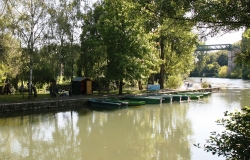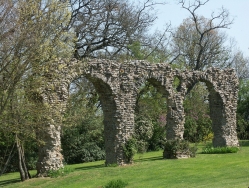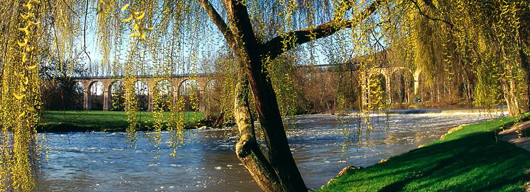
The Natural heritage of Saint Benoît is very much protected. So come and stroll along the banks of its rivers and streams and discover the wealth of their flora, fauna and trees.
The banks of the Clain river
The ever-changing landscapes along the Clain ensure a great experience; the banks of the river start at the foot of the Ermitage complex, a place known as “La Varenne” – a varenne is the generic name of land by a river used to grow hemp.
The vallée du Clain park, with 5 kilometers of river bank (from l’Ermitage to Passelourdain) is owned by the town, thus ensuring that this delightful site be well-kept and protected for all to enjoy.
The canoeing centre
Long ago this was a paper mill, built in 1869, which belonged to the abbey. The oldest part of the mill has been transformed into a canoeing centre. A flour mill, which stood on the site at the turn of the last century, built by a mayor of the town, was demolished in 1974.
Miosson valley
This small, tidy river wends its way through many of La Vienne’s towns and villages before flowing into the Clain at Saint Benoît. Peaceful strolls along its banks reveal an exceptional natural heritage of greenery and welcome coolness.

The rich and varied architectural heritage of Saint Benoît must be explored.
The Church of Saint Benoît
Where the valley opens out onto the plain, encased between the steep slopes of the town and the wooded hillsides, this superb, single-naved Romanesque church with its Gothic spire stands tall. The façade dates from the XIth century. Inside the church admire the vestiges of mural paintings and a XVth century recumbent statue as well as XIIth century sarcophagi and a XIIIth century Limousin enamelled crosier. The spire of the belfry is Gothic but the main part of it is Romanesque like the rest of the building.
The Abbey
Founded in the VIIth century by Saint-Achard, destroyed in the IXth century and rebuilt throughout the XIth and XIIth centuries only the chapter house remains from the original building; exclaim at the beautifully sculptured capitals and, on the first floor, in the Monks’ Dormitory, stand in awe at the vault which resembles the inverted hull of a boat. Restoration of the abbey was carried out under the aegis of the Bâtiments de France following the restoration of the church (1971-1984) and abbey lodging house in the priory cul-de-sac.
Abbey Lodging House
The old abbey lodging house and the small XIIth century passage taken by the monks to reach the cloisters appear as if by magic at the end of the priory cul-de-sac. Since its restoration it is the cultural centre of the priory, housing the library, IT club and Visual Arts association.
Parigny Arches
Dating from I B.C.., the arches are the remains of a Roman aqueduct, which crossed the small dry valley of Saint Benoît whilst maintaining the desired water level, thus allowing water to reach Limonum (the old name for Poitiers). They can be seen from the gardens of the Ermitage complex and the park of the SAT factory.
The Viaduct
This was used to link Poitiers and Saint Martin l’Ars by means of a steam tram. It measures 328m long and stands 20m high. Today it is reserved for pedestrians, who are treated to a wonderful view of the river Clain. Building of the viaduct began in 1892. Opened on July 5th 1896, it ran the last tram on June 30th 1934.
Sainte-Croix Abbey
Founded in Poitiers by Sainte Radegonde in 552A.D, the abbey was transferred to the calm and green Domaine de la Cossonière in Saint Benoît in 1965. The Miosson stream flows through the 29 hectare domain. Contemplative Benedictine nuns receive those persons seeking peace and quiet and engage in making hosts for the Mass.



